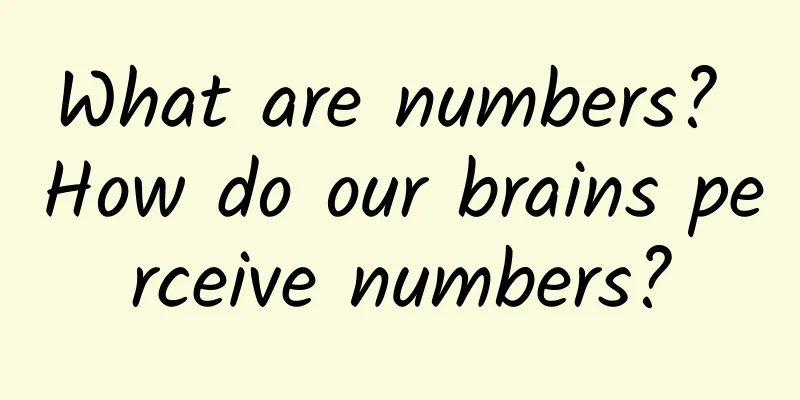What are numbers? How do our brains perceive numbers?

|
A philosophical question has gradually evolved into a scientific one. There is still a long way to go. Written by Xu Zilong (Southeast University) What are numbers? How do we perceive numbers? This seems to be a very simple and naive question. But in fact, in the philosophy of mathematics, this is a very basic question that has remained unsolved. As early as the ancient Greek period, some philosophers raised this question. This article attempts to look at how humans strive to find the answer to this question from multiple perspectives, including biological evolution, psychology, neuroscience, and philosophy. Smart "BMW" Hans Humans can recognize numbers and do calculations. Is this a uniquely human ability, or is it an evolutionary heirloom inherited from our animal ancestors through our genes and stored in our brains? Are humans really the only ones who can perceive numbers? Can animals do it, too? Let’s listen to a story about BMW Hans from a hundred years ago. Figure 1. Mathematics teacher Wilhelm von Osten and his horse "Hans" | Source: Wikipedia In 1904, German mathematics teacher Wilhelm von Osten introduced a horse he trained, named Hans, known as "Smart Hans" (Figure 1), to a Berlin audience. When von Osten wrote an equation on the blackboard, such as "2+3", Hans would tap his hooves accurately five times and then stop. Hans could also solve more complex arithmetic problems (Figure 2). At the time, some people suspected that this was a circus trick, and thirteen famous experts and scholars (including philosophers and psychologists) formed a "Hans Committee" to investigate the matter, but they ultimately did not find any scam. Figure 2. Testing Hans’ mathematical calculation ability | Source: Wikipedia Later, German psychologist Oskar Pfungst (1874-1932) investigated Hans again. Pfungst found that the horse could give the correct answer even if it was not von Osten himself who asked the question, which ruled out the possibility of cheating by the horse's owner. Importantly, however, Hans only got the correct answer when the questioner knew what the answer was and the horse could see the questioner. If the questioner did not know the result or was out of the horse's sight, Hans could not answer the question. Pfungst then concluded that Hans did not really know how to do arithmetic, but used the unintentional physical cues of the questioner to answer the questions. When Hans tapped his hoof, it would observe slight changes in the posture, facial expressions or breathing patterns of the questioner and the onlookers, and stop tapping at the right moment. Based on this, he proposed the so-called "Hans effect" (Figure 3). Figure 3. Smart and unintelligent Hans. Left: When there are many spectators watching, Hans can recognize numbers; Right: When there are no spectators and the questioner is out of the horse's sight, Hans cannot complete the task. Source: Wikipedia This shows that the Hansma is not that smart. It does not really do mathematical calculations, but only reacts by observing the movements and expressions of the people around it. From this point of view, we can think that animals are spiritual, but it cannot prove that animals have the concept of numbers. Psychologist Funster wrote in his article [1]: "Numbers are indispensable to our daily lives. But what use was number perception to our ancestors before they became Homo sapiens? Did animals use numbers from the beginning? According to the principle of evolutionary adaptation, it is obvious that number perception would only be maintained in populations, sometimes for millions of years in large animal taxa, if it was beneficial (or at least harmless) to the individual." Human digital perception from the perspective of biological evolution In order to survive and reproduce, animals must adopt certain strategies to ensure their own survival until they reach sexual maturity and can reproduce. For some species, this also requires caring for their offspring to ensure that they survive long enough. For an individual, this first means finding food and avoiding becoming food, choosing the right path in a cluttered environment, and helping friends in daily affairs. Logarithmic perception can help animals achieve these goals. Research shows that logarithmic perception can enhance an animal's ability to find food, catch prey, avoid predation, navigate its habitat, and persist in social interactions. 1. Navigation Animals often use landmark counting to find a suitable route. For example, bees rely on landmarks to measure the distance between food and the hive. In an experiment studying bee behavior[2], researchers placed four tents and a feeder filled with sugar water between the third and fourth tents. Bees will identify the tents as landmarks and use them as a navigation basis to find food. Changing the number of tents and the distance between them will affect the bees' judgment of distance. It is still unclear whether bees directly record the absolute distance they fly or measure distance by counting landmarks (here, tents). However, the number of landmarks is still an important factor. 2. Hunting Ordinary spiders are solitary animals, but spider-eating spiders that feed on spiders are social animals, with some individuals gathering together for a relatively long time. This is the case with a species of spider-eating spider called Portia africana (hereinafter referred to as Portia) in Kenya. The small spiders they hunt like to build tent-shaped silk nests on boulders, tree trunks, and the walls of buildings [3]. Portia usually use quantitative clues when hunting. Take a typical scenario as an example: two Portia settle next to the nest of a prey. When one Portia catches prey, the other Portia will join in and eat together. How does Portia decide which prey spider's nest to settle near? The basis is the number of companions who have already settled there. They prefer to hunt in pairs, rather than hunting alone, and are not happy to hunt with two, three or more companions, because the more members a hunting team has, the more likely some members are to not cooperate, resulting in large groups often catching prey worse than small groups. It seems that the principle of "two monks carrying water to drink, three monks have no water to drink" is understood not only by humans but also by spiders. 3. Avoid being preyed on Animals that lack the ability to defend themselves often seek shelter in large groups of social partners. By joining a large group, each individual has a lower chance of becoming prey. Therefore, for many fish, joining a school is the primary anti-predator strategy. The larger the school, the better it is for the fish. When a single fish or a few fish arrive in an unfamiliar and potentially dangerous environment, they often join other fish of the same species. If there are two schools, they will usually join the larger one, which means that they are able to distinguish between larger and smaller schools. Therefore, the ability to compare the number of conspecifics can be crucial in life-or-death situations. 4. Social Territory Defense If individuals cannot defend resources alone, groups and group size are important. Many animals live in social groups and work together to defend against intruders. Defending territory often means potentially lethal conflict with rival groups, so animals need to be able to assess the size of their own group and that of rival groups - an ability that clearly has adaptive value - as it is the basis for decisions to attack or retreat. An assessment of group size is clearly a sense of the number of individuals in the group. “There is strength in numbers”, and animals also understand this truth. The concept of number and its cognitive psychology mechanism Numbers and digits are everywhere in our daily lives. When we were just learning to speak, our parents began to teach us to recognize numbers, count fingers, and read numbers... So, what is the concept of numbers? How do people represent numbers? To answer these questions, we need to first understand what types of numbers there are, what they mean, and what are the differences between different types. The first type of number concept is cardinal number. Cardinal number represents quantity, that is, the concept of "how much". The basic function of cardinal number is counting[4]. Cardinal numbers are very common in daily life. For example, there are 5 mangoes in a fruit basket and 12.34 yuan in the account. The "5" and "12.34" here respectively represent the number of mangoes and the amount of money, so it is a cardinal number. In mathematical set theory, the number of elements in a set is called the cardinality of the set. The second type of number concept that we often come into contact with is the ordinal number. Ordinal numbers represent the order of entities, or the order of ranking. For example, when playing the game PlayerUnknown's Battlegrounds, if you are lucky enough to eat a "chicken", you will also get the first place. The 1 here obviously does not represent the number, but the ranking, so it is an ordinal number. The third type of number concept is the so-called label. Labels do not indicate the quantity or ranking order, but simply use numbers as a mark to distinguish different objects or subjects. Some of the most common examples are ID card numbers, bank account numbers, and QQ numbers. The several types of number concepts actually originate from people's abstraction of different empirical properties. The figure below fully represents the structure of the above three concepts of numbers. Figure 4. We often use three types of numerical concepts to represent three corresponding empirical properties [1] So, how does the human mind represent and process information about numbers? There is a very important concept in cognitive psychology, which is representation. Representation means the psychological model or diagram of the external real world in the human brain, or the abstraction of real objects by the human cognitive system. Let's take a simple example. There is a water cup on the table at home. We know it is a water cup. When we see a water cup on someone else's table at work, although it is different from the one at home, we also know it is a water cup. Or when we see various water cups on the shelves of a store, although they are all different from the one at home, we also know that they are water cups, and we will not mistake them for chairs, flowers, or cats. When we close our eyes, although we can't see anything, the appearance of the water cup can still appear in our mind. In essence, we have a concept of a water cup in our mind, and this concept is abstracted from the concrete objects in reality. There are two basic types of mental representations of numbers: symbolic and non-symbolic. Both cardinal and ordinal numbers have both types of representations. Labeled numbers, on the other hand, have only symbolic representations[1]. Symbolic representation refers to the use of symbols (such as Arabic numerals) to represent the concept of number[5]. Non-symbolic representation refers to the use of symbols to represent numbers intuitively, through related graphics (such as an array of dots) that refer to the actual number of elements, rather than using symbols. The non-symbolic representation of numbers is a perceptual representation of the size of a set, which is the correspondence between the number of elements actually perceived and the number represented. A typical representation method is to use a number of elements scattered in space, such as points in a dot matrix, to represent the corresponding number. At this time, people can instantly and simultaneously perceive the number represented by the points. Whether from the perspective of animal evolution or human development, non-symbolic representation of numbers is a primitive representation method. Animals have non-symbolic representation, and humans also have it in infancy. If a person has never learned the symbols of numbers (numbers), then he can only use non-symbolic representation [1]. Two ways of representing numbers are shown in Figure 5. Figure 5 (A) represents two quantities: 8 and 12, by the number of dots, while Figure 5 (B) directly represents the quantity through symbols - Arabic numerals. Figure 5. Symbolic and non-symbolic representations of numbers[6]. (A) Non-symbolic representation; (B) Symbolic representation A long time ago, some people studied the cognitive development process of infants and young children regarding numbers. Researchers believe[7] that infants and young children’s representation of numbers has gone through three stages of development. In the first stage, infants and young children will remember the pronunciation pattern of numbers; in the second stage, they will remember the writing pattern of numbers and associate it with pronunciation; the third stage is called the symbolic representation stage, in which infants and young children will form an internal representation of numbers. Other studies have shown that in early childhood, the symbolic representation skills of numbers are the main factor affecting children’s math level. However, as children grow older, the impact of symbolic representation skills and non-symbolic representation skills on math level tends to decrease [6]. There is another interesting question: Does human perception of numerical values have an automated process? The study found the following conclusion: If numbers are presented in the form of graphics, when the value is less than 4 (that is, 1, 2, 3) (as shown in Figure 6), people can perceive the number of graphics almost instantly. This process is called subitizing. Figure 6. When a non-symbolic number is less than 4, it can be estimated instantly [6] But if the value is greater than or equal to 4 (as shown in Figure 7), it is impossible to estimate it instantly. We can only count them one by one. This counting process is called counting. When counting, we may read out loud or just recite in our mind. In short, at this time, we must use language symbols to figure out how many shapes there are. Figure 7. When the non-symbolic number is greater than or equal to 4, it cannot be estimated instantly and can only be counted [6] Figure 8. The effect of non-symbolic numerical representation on perceptual reaction time and error rate [6] The research results (Figure 8) show the impact of non-symbolic numerical values on people's perception of numbers. The horizontal axis of the figure represents the numerical value, the vertical axis of the left figure represents the reaction time, and the vertical axis of the right figure represents the error rate. From the figure, we can clearly see that as the numerical value increases, the reaction time increases, and the error rate also increases. When the numerical value is 1, 2, and 3, the changes in both are very small. When the numerical value is around 4, the increase in both is very obvious. This may be related to the attention span of people. Neural mechanisms of number concepts The physiological basis of cognitive activities is the nervous system. So, what kind of neural mechanism produces the human perception of the concept of numbers and the psychological representation of numbers? To answer this question, cognitive neuroscience researchers use a variety of non-invasive techniques to measure the activity of neurons during mathematical tasks. One of the most commonly used methods is functional magnetic resonance imaging (fMRI). This technology can detect the activation of the cerebral cortex, so that researchers can observe which part of the brain is more active when human subjects perform a certain cognitive task. Obviously, the active brain area or areas may be closely related to the cognitive activity currently taking place. In 2003, a French research team used fMRI to scan the brain activity of subjects when they were perceiving numbers[8]. The scanned images showed (as shown in Figure 8) that neurons in three brain regions were relatively active: the bilateral horizontal segment of intraparietal sulcus (red area), the bilateral posterior superior parietal lobe (blue area), and the left angular gyrus (green area). In other words, these areas are all involved in the cognitive/psychological process of perceiving numbers. Figure 9. Brain regions active in a number perception experiment [8] From the figure, we can also see that the left brain has more activated areas than the right brain, which means that when humans perceive the concept of numbers, the left brain may provide more neural resources than the right brain. In 2004, an Italian research team used another approach to study the brain area involved in number perception[9]. They used transcranial magnetic stimulation (TMS) technology: the experimental equipment can generate a magnetic field that passes through the skull, interferes with specific brain areas, inhibits their neuronal activity, and causes "virtual damage." This process is also non-invasive (Figure 10). The experimenters asked the subjects to do a simple number perception task, and at the same time used the magnetic field transmitting device to interfere with the inferior parietal lobule (IPL) area (equivalent to the red area in Figure 9). The results showed that the accuracy of the subjects in completing the task decreased and the reaction time increased. Once the device was removed, the accuracy of the subjects in solving the problem quickly rose again, and the reaction speed returned to normal. As a control, the experimenters also aimed the device at brain areas unrelated to number perception. Sure enough, the interference with these brain areas did not affect the subjects' completion of the number perception task. Figure 10. Transcranial magnetic stimulation equipment and operation | Image source: Internet Furthermore, scientists have also studied the activation of brain regions when we perform addition, subtraction, multiplication, and division operations. This can help us understand whether the neural activities that cognitive processes rely on are different when performing four different operations [10]. Figure 11. Brain activity during the four arithmetic operations. From top to bottom, they are addition, subtraction, multiplication and division. [10] Figure 11 shows the results of the experiment. The colors indicate the brain areas that are activated (red and yellow) and inhibited (blue and green) when doing calculations. As can be seen from the figure, when doing multiplication and division, the activated brain areas are far more than addition and subtraction, which means that multiplication and division require more cognitive resources - in other words, multiplication and division are more difficult. This result is completely consistent with our common sense. At the same time, we can also observe that the left intraparietal sulcus (Left IPS) area is activated in each operation. Therefore, it can be considered that this area is involved in each operation and is a very important brain area related to calculation. In addition to fMRI and TMS, there are many other non-invasive technologies for studying brain activity, such as electroencephalography (EEG), magnetoencephalography (EMG), near infrared, etc. There is also a vast amount of neuroscience literature using these technologies to study number perception and mathematical ability. Many questions have not yet received definite and unified answers, and many conclusions are also temporary. The research examples cited above are only a small part of the whole. To answer the question "How does the brain perceive numbers?", we still need to do more exploration. Summarize The "numbers" we come into contact with every day in our daily lives, are they something that existed originally and was discovered by humans, or are they the product of human invention? As Mario Livio, author of Is God a Mathematician?, explains, this question has long puzzled mathematicians. Figure 14. The Last Mathematical Problem (Posts and Telecommunications Press, September 2019) One group adheres to realism, believing that numbers exist independently of human thought and we just discovered them. The other group supports anti-realism, believing that numbers are not independent of our perception and we invented them. Perhaps this issue will continue to cause controversy for quite a long time in the future. However, with the development of cognitive psychology and cognitive neuroscience, people are getting closer and closer to the mystery behind the cognition of numbers. References [1] Nieder, A brain for numbers: the biology of the number instinct. MIT press, 2019. [2] L. Chittka and K. Geiger, “Can honey bees count landmarks?,” Animal Behavior, vol. 49, no. 1, pp. 159–164, 1995, doi: https://doi.org/10.1016/0003-3472(95)80163-4. [3] XJ Nelson and RR Jackson, “The role of numerical competence in a specialized predatory strategy of an araneophagic spider,” Animal cognition, vol. 15, pp. 699–710, 2012. [4] https://en.wikipedia.org/wiki/Cardinal_number [5] https://dictionary.apa.org/symbolic-representation [6] Y. Li, M. Zhang, Y. Chen, Z. Deng, X. Zhu, and S. Yan, "Children's Non-symbolic and Symbolic Numerical Representations and Their Associations With Mathematical Ability," Frontiers in Psychology, vol. 9, 2018. [7] E. Bialystok, “Symbolic representation of letters and numbers,” Cognitive Development, vol. 7, Art. no. 3, 1992. [8] S. Dehaene, M. Piazza, P. Pinel, and L. Cohen, “Three Parietal Circuits For Number Processing,” Cognitive Neuropsychology, vol. 20, no. 3-6, pp. 487–506, 2003, doi: 10.1080/02643290244000239. [9] M. Sandrini, PM Rossini, and C. Miniussi, “The differential involvement of inferior parietal lobule in number comparison: a rTMS study,” Neuropsychologia, vol. 42, no. 14, pp. 1902–1909, 2004, doi: https://doi.org/10.1016/j.neuropsychologia.2004.05.005. [10] M. Rosenberg-Lee, TT Chang, CB Young, S. Wu, and V. Menon, “Functional dissociations between four basic arithmetic operations in the human posterior parietal cortex: A cytoarchitectonic mapping study,” Neuropsychologia, vol. 49, no. 9, pp. 2592–2608, 2011, doi: https://doi.org/10.1016/j.neuropsychologia.2011.04.035. This article is supported by the Science Popularization China Starry Sky Project Produced by: China Association for Science and Technology Department of Science Popularization Producer: China Science and Technology Press Co., Ltd., Beijing Zhongke Xinghe Culture Media Co., Ltd. 1. Go to the "Featured Column" at the bottom of the menu of the "Fanpu" WeChat public account to read a series of popular science articles on different topics. 2. Fanpu provides a function to search articles by month. Follow the official account and reply with the four-digit year + month, such as "1903", to get the article index for March 2019, and so on. Copyright statement: Personal forwarding is welcome. Any form of media or organization is not allowed to reprint or excerpt without authorization. For reprint authorization, please contact the backstage of the "Fanpu" WeChat public account. |
Recommend
3 Operational Guidelines for APP Product Loss User Research: Why Do Users Leave?
Before actually contacting users for research, th...
Is there nitrite in hot pot? 7 tips for eating hot pot healthily
There was a food safety news recently, saying tha...
A man who stayed up until 3 a.m. every night was diagnosed with stomach cancer! Staying up late is more terrible than you think
Yesterday, a news story about a man who stayed up...
What can Foshan enterprises do by developing mini programs?
Mini Programs are a new way to attract new users....
World Economic Forum: What other areas of cooperation are there between China and the Gulf region besides oil?
China and the Gulf Cooperation Council countries ...
Learn from dolphins! Learn the secrets of sound waves and become more comfortable underwater~
Author: Li Chuanfu In the depths of the ocean, do...
Youzi operates two hours a day and earns more than 1,000 yuan a day.
This project was created when I was researching p...
What is it like to de-ice an astronomical telescope millions of kilometers away?
"The de-icing program should restore and pre...
Chinese polar exploration: from Dayu's flood control to the "Central Kingdom"
In recent years, the topic of the migration of an...
Cheng Guangjian sales negotiation and professional payment collection skills video
Mr. Cheng Guangjian has worked for companies incl...
Can LeTV X55, the evolution of super TV, become a new benchmark in the industry?
When LeTV first entered the smart TV field, it na...
Extending the life expectancy of mice and monkeys? You can get this health "all-rounder" with just a little effort!
If you say there is something that can resist agi...
Five reasons why Apple could develop a professional camera product
Although we don't know what industry Apple wa...
Why does the peony become the "national flower" by surpassing the peony?
Although there is no final conclusion, if asked w...
A practical example of setting up FEED for Douyin live broadcast room. Do you want to learn it?
In May, ByteDance launched the FEED direct live b...









